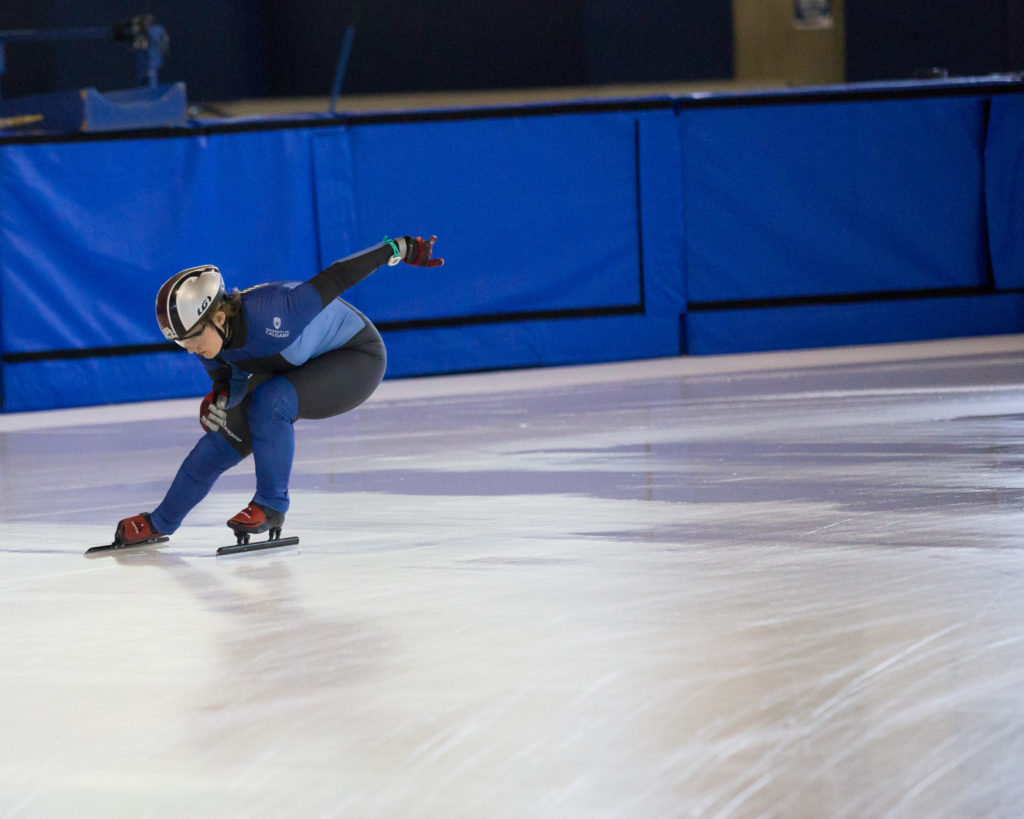
Balancing life as a competitive short track speed skater
By Anneke Pederson, July 26 2016 —
On the far side of campus, through the hallways of the Kinesiology complex and beyond the Outdoor Centre, lies one of the University of Calgary’s most decorated athletics facilities.
Here stands the Calgary Olympic Oval, a building that has housed many of Canada’s top Olympic athletes. Catriona Le May Doan. Cindy Klassen. Jeremy Wotherspoon. They’re names you might recognize — and all of them made their mark right here on campus.
I made the move from St. Albert to Calgary at the end of high school to follow in their footsteps. I was ecstatic the day I found out that I had made the cut for the Olympic Oval’s elite high
performance speed skating program. I had been a short tracker for most of my life, but nothing could prepare me for the amount of training and discipline it would take to get to such a high level of sport.
These days, I spend most of my time either recovering from a hard session or in middle of one, pushing my body to nausea and praying that the feeling will die down before the next set. Don’t get me wrong, I’m thrilled to be here — how could I not be, now that I have a team of people ready to make sure that my body is mentally and physically prepared to perform every day? At this level of sport, the amount of dedication from coaches and other support staff involved in the program is incredible. And it’s needed, too.

Short track speed skating is a sport that requires years of technical development. To most people on the outside, these athletes might seem closed off from the world. But that’s mostly because of the amount of focus it takes to improve daily, and the kind of drive you need to push yourself beyond your limits.
Short track is not just a technical sport — it’s a tactical one. If you come to a session unfocused you might as well not be there. Speed skaters train with five to 10 people on the ice each day, and we skate together in packs of about the same number. In races, it takes everything you have to keep from losing an edge while getting pushed around from all sides. And maintaining good form — which we call “basic position” — seems impossible when your legs are aching from lactic acid buildup.
If you’re skating in a pack or doing relays and your brain is out to lunch, someone could get hurt. And when you’re practicing twice a day, six days a week, you’re physically and mentally exhausted. I have so much admiration for my teammates who have been involved in this program for years while working or going to school — sometimes both. Most of us attend classes in between training sessions, decked out in workout gear and neon running shoes.
With all the hard work it takes to maintain the life of a student athlete, you might ask why we do this to ourselves, day after day, year after year. But the answer lies in the massive payoff after sacrificing so much.
It’s the exhilaration of weaving through the pack to be in that top spot, the satisfaction of besting a difficult opponent or perfecting a technical component that has been slowing you down. It’s finally finishing the final set of a hard workout, legs barely able to hold you up, surrounded by red-faced teammates patting you on the back saying, “we did it.” It’s seeing yourself grow, not just as an athlete, but as a person.
Because of this sport, I have learned more about myself and the ins and outs of what my body needs to perform at its best than I have doing anything else. And when it’s time to hang up the skates, I know that these skills I’ve learned will help me get through just about any challenge I have yet to face.
But I’ve still got plenty of years of racing left in me.
